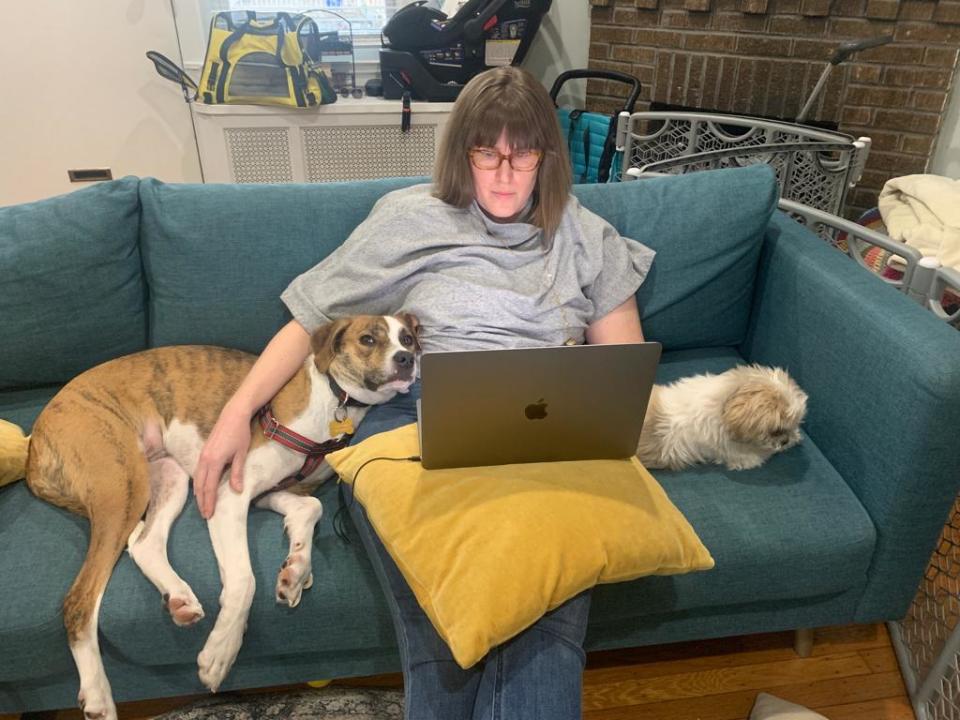Millennial Moms Are At Capacity "All The Time" And It's Time We Acknowledge This As A Society

I was settling in for an interview over Zoom when I glanced at my baby monitor and saw it: the unmistakable wiggle of a toddler who’d pooped himself awake from a nap. I sighed and set the monitor aside. I had no choice but to wait till after the call to check on him.
When the Zoom ended, I dashed in to clean him up, then texted my friend a photo of the three of us (my baby, myself and my laptop). “Look at me,” I wrote wryly. “I have it all.”
I started thinking a lot about “having it all” after my son was born in late 2021. I went back to work after four months of parental leave, breast-pumping my way through phone calls and changing diapers on the sly. I loved being close to my son and was lucky to have a husband who thrived as a stay-at-home dad, but it was all so completely exhausting. For every stolen midday snuggle there was sobbing (on both sides of the door) when I had to close my eyes and tune out my son’s cries for Mommy as I buckled down to get a project done.
Surely, I often thought to myself, this isn’t what Helen Gurley Brown had in mind when she published “Having It All,” her famed book of advice on balancing sex, work, relationships and more, in 1982. I may have a career and a family, but I often “have it all” — or, rather, do it all — at the exact same time.

In the summer of 2012, just a couple of years into my journalism career, The Atlantic published Anne-Marie Slaughter’s culture-defining text, “Why Women Still Can’t Have It All.” In it, she described stepping back from powerful government work to be closer to home and more available to her two teenage sons, and she outlined the workplace changes she saw as necessary to allow ambitious women to pursue big careers and remain present mothers.
I read it hungrily, feeling smug about my own ambivalence toward motherhood. At 25, I was climbing the career ladder fast and loving it. Why derail the train with a baby when the ride was so exciting? Plus, I couldn’t imagine a world where Slaughter’s proposed changes — more flexible schedules, remote work, less business travel, teleconferencing instead of in-person meetings — would materialize. Little did I know a global pandemic would abruptly shift that tide.
A decade later, in a post-COVID world, I had, in many ways, exactly what Slaughter had described: an exciting career with a flexible, remote job that allowed me to be close to the baby I’d decided I wanted. But I also had a hefty dose of burnout. For me, it was all too much — the constant doing it all. And I was losing my ambition as a result.
I’m not the first millennial mom with an office job to feel this way. Between lazy girl jobs, the death of the girlboss and the countless ambitious women who’ve written about losing their drive in recent years, the collapse of millennial women’s ambition is well-documented. Heck, we now even have the millennial mom midlife crisis.
But it’s no wonder: Millennial moms work more than previous generations of mothers, and we spend more time parenting our kids, plus our parents can’t or don’t want to help us out (or need care themselves). And then there’s the astronomical cost of child care. We are at capacity all the time, even with the trappings of professional flexibility.
I decided to ask Anne-Marie Slaughter what comes next.
The workplace transition isn’t over yet.

Slaughter acknowledged that we’ve made strides toward her envisioned workplace, but we’re not there yet.
“We’ve transitioned the where we can work, and we have the flexibility — so now, if your kid is sick or you have a teacher’s conference or you need to take a parent to a doctor’s appointment, you have the flexibility to do that,” she said. But we haven’t reached the place where professional and personal ambition can coexist.
Aside from major structural changes we know are needed to support families — such as 12 months of parental leave, plentiful and affordable child care, free pre-kindergarten and well-funded public schools — there is one big thing that needs to change in the workplace, according to Slaughter: management practices. Face time is still the reigning tool for performance measurement, and that disadvantages anyone working remotely.
“If you’re in the office and that other person is in the office, you are still going to have a better sense that they are working than the person who is not [in the office],” she said. “I’ve said for a long time, to really make this work, you have to have much more objective and precise management practices, and that takes more work. I don’t think we’re there yet.”
Indeed, McKinsey’s Women in the Workforce reports from both 2022 and 2023 found that women in leadership are leaving their roles in record numbers, in part because their labor isn’t being recognized by their superiors. They’re taking on diversity, equity and inclusion work or heading up employee resource groups in addition to their full-time roles, for example, but it’s not being counted toward their overall performance, and they’re working remotely (often to juggle family responsibilities), which is being counted against them.
“They are looking for the ability to advance. They are looking for flexibility and choice in terms of where, when and how they work. They are looking for companies that authentically prioritize DE&I. They are looking for people who are backing their careers,” said McKinsey senior partner Lareina Yee in a podcast about the 2022 report. But, quite frankly, she said, “companies haven’t stepped up.”
Beyond changes in performance evaluation and management, Slaughter also advocates for what she described in her Atlantic article as “investment intervals,” the idea that you grind hard in certain periods of your work life ― early in your career before you have kids, for example ― and then make different choices as your career moves forward, including saying no to promotions that won’t work for your family life or taking time off from full-time work to consult, take a sabbatical or accept project-based work. Then when your kids are grown, you can lean back in and keep rising.
In my view, when it comes to frazzled millennial moms, a wholesale shift in the way we understand and reward professional ambition is due. Forget this idea that moving up, down, back or sideways in your career is a sign that you’re not committed. Instead, we must think of ambition as a tide — sometimes rolling in, sometimes rolling out, always doing its part. Under this rubric, millennial moms aren’t losing their ambition, they’re simply moving with the tide, and there’s no reason to feel ashamed about that. We shouldn’t be sent back to square one in our careers simply because the tide of our ambition went out while our children needed us most.
Slaughter said that taking a break to have kids or to work on professional development isn’t the kiss of death that it used to be, but “there are still plenty of workplaces where, if you get knocked off that straight-up path, it’s going to be very, very hard to get back on. I can see it changing; it just hasn’t changed yet.”
At her company, New America, Slaughter said she’s found that a flexible and supportive culture, which includes hybrid work, paid parental leave and a “family comes first” mantra, has ensured the work always gets done without sacrificing people’s personal lives and has also helped more junior staff find opportunities to rise and be seen.
Parental leave, for example, “creates opportunities for other people, younger people, other members of the team” to step in and work with Slaughter and other senior staff who they might not have otherwise crossed paths with directly. “It builds resilience in the workplace.”
Embrace a holistic view of ambition.

Slaughter sees millennial and Gen Z workers rejecting the old hustle-culture model and applauds it, but also notes that many of us aren’t sure where to go from here. “There’s a sense that the world that we knew is coming apart in many ways, and people are not sure what they should be wanting,” she said. “But they know that the traditional whatever it was that was going to make you happy is not likely to.”
That said, she thinks the idea of striving to be a “whole, healthy person” is a move in the right direction. “By whole, I really do mean having different dimensions to your life. That could be work and family, that could be sports, hobbies, friendships.”
She doesn’t even use the phrase “having it all” anymore.
“The whole framing makes me uncomfortable, even though that is the phrase I grew up with that meant having a career and a family,” she said. “There’s a hyper-capitalist dimension to it” that runs counter to the way most millennials and Gen Zers think about their lives. It’s time we tossed it for good and focused on building workplaces that support the multidimensional lives of all workers.
As for our millennial mom midlife crises and waning ambition? Slaughter advises us all to hang in there.
“It is a life passage that many, many, many people go through. We are maturing into our fuller selves who realize that there’s more to life and there’s more to ambition. I have plenty of ambition. It’s just not expressed in the way that it once was, to climb to the top of a particular ladder.”This article originally appeared on HuffPost.


